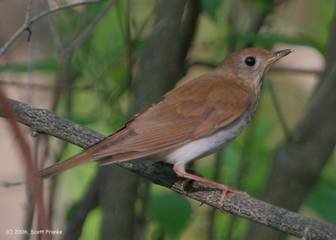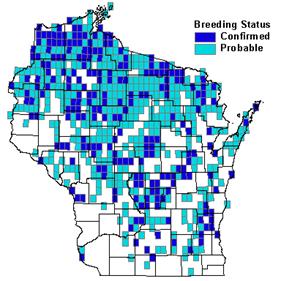Photo by Scott Franke


Status/Protection
- Global Rank: G5 Key to global and state ranks
- State Rank: S4B
- WBCI Priority: SGCN, PIF, State Special Concern
Population Information
Federal BBS information can be obtained at http://www.mbr-pwrc.usgs.gov/bbs/bbs.html by clicking on Trend Estimates and selecting the species in question. All estimates are for 1966-2005.
- Federal Breeding Bird Survey: significant decline
- Federal Breeding Bird Survey (WI): significant decline
- Federal Breeding Bird Survey (BCR 23): significant decline
- Federal Breeding Bird Survey (BCR 12): significant decline
- Chequamegon National Forest Bird Survey (NRRI): significant decline (1990-2006)
- WSO Checklist Project: stable (1983-2007)
Life History
- Breeding Range: British Columbia east across southern Canada and the northern U.S. to the Atlantic Coast (Moskoff 1995).
- Breeding Habitat: Northern Hardwood, Swamp Hardwood, Alder Thicket, Shrub-Carr, Swamp Conifer-Balsam Fir, White Pine.
- Nest: Cup, on or near the ground (Ehrlich et al. 1988, Moskoff 1995).
- Nesting Dates: Eggs: late May to early July (Robbins 1991).
- Foraging: Ground glean, swoops, foliage glean (Ehrlich et al. 1988).
- Migrant Status: Neotropical migrant.
- Habitat use during Migration: Low vegetation in all forest types, forest edge (Moskoff 1995).
- Arrival Dates: Late April to late May (Robbins 1991).
- Departure Dates: Mid-August to late September (Robbins 1991).
- Winter Range: South-central and south-eastern Brazil (Remsen 2001).
- Winter Habitat: Tropical forests including broadleaf evergreen forest, forest edge, second-growth woodland (Moskoff 1995).
Habitat Selection
The Veery is considered to be a “forest habitat generalist” in the northwoods (Pearson and Niemi 2000). In northern Wisconsin, Veeries occur fairly commonly in northern mesic forests (Hoffman 1989a), shrub carr and alder thickets (Hoffman 1989b), boreal forest (Mossman et al. 1990), conifer bogs (with hardwood understory) and hardwood swamps (Hoffman and Mossman1993), moist white pine forests (Hoffman and Mossman 1990), and deciduous forest types on the Apostle Islands (Temple and Harris 1985). They occur uncommonly in southern floodplain and moist upland forests (Mossman 1988, Mossman and Hoffman 1989), and rarely in other forested habitats such as pine and oak barrens (Mossman and Epstein 1991). These studies and Wisconsin Breeding Bird Atlas data (Epstein 2006) concur that Veeries are able to use a wide variety of mesic to wet forest cover types and successional stages provided there is thick deciduous undergrowth present. Veeries are an area-sensitive species. In Illinois Herkert (1995) found the average forest size of a Veery breeding area to be 309 ha. In southern Wisconsin, Veeries are likely to be found only in woodlots larger than 25 ha (Temple 1989). Veeries nest on the ground or within approximately 1.5 meters of the ground. Ground nests are sometimes situated at the bases of stumps, under fallen logs, or in clumps of grasses or mosses (Moskoff 1995).
Habitat Availability
Veeries are found in a wide variety of forest habitats, resulting in a broad distribution throughout the state. They are most common in northern and central Wisconsin forests, but also occur southward in large forested tracts such as the Baraboo Hills (Mossman and Lange 1982), the Wyalusing area in Grant County, and the Kettle Moraine State Forest. Many of these forest habitats used by Veeries remain common throughout the state, although forest fragmentation is a concern.
Population Concerns
This species remains widespread and relatively common in Wisconsin where breeding activity was documented in 60% of quads surveyed during the Wisconsin Breeding Bird Atlas (Epstein 2006). However, Breeding Bird Survey data suggest significant declines in Wisconsin and range-wide for this species (Sauer et al. 2005). Factors influencing these declines are not well understood. Habitat fragmentation and concomitant nest parasitism may play a role. Increased browsing of understory by growing populations of white-tailed deer is likely problematic in many areas, but this remains undocumented (Moskoff 1995). Habitat destruction on the wintering grounds also is cause for concern.
Recommended Management
Management efforts for Veery should focus on maintaining patches of dense deciduous understories within large forest blocks. Reducing deer densities in known Veery breeding areas may be one conservation strategy. However, addressing habitat loss on the wintering grounds should be a high priority since it is unclear if this is the primary limiting factor of this species. Conservation and management strategies for this species should be focused in the following Wisconsin ecological landscapes: Central Lake Michigan Coastal, Central Sand Hills, Central Sand Plains, Forest Transition, North Central Forest, Northeast Sands, and Northern Highland (WDNR 2005).
Research Needs
Research is needed regarding the impacts of habitat loss and fragmentation on both the breeding and wintering grounds. More information is needed on different aspects of the Veery’s breeding biology, including nest site selection and occurrence of multiple broods. Studies that investigate the reproductive success in various habitats are warranted (Howe et al. 1992). Finally, research into the wintering distribution of this species is urgently needed.
Information Sources
- Chequamegon National Forest Bird Survey (NRRI) species account: http://www.nrri.umn.edu/mnbirds/accounts/VEERa2.htm
- Nicolet Northern Forest Bird survey map: http://www.uwgb.edu/birds/nnf/species/VEER.htm
- North American Breeding Bird Survey: http://www.mbr-pwrc.usgs.gov/bbs/bbs.html
- Temple S.A., J.R. Cary, and R. Rolley. 1997. Wisconsin Birds: A Seasonal and Geographical Guide. Wisconsin Society of Ornithology and Wisconsin Department of Natural Resources, Madison, WI.
- Western Great Lakes Bird Conservation priority species map: http://www.uwgb.edu/birds/greatlakes/species/veermap2.htm
- Wisconsin Breeding Bird Atlas: http://www.uwgb.edu/birds/wbba/
References
- Ehrlich, P.R., D.S. Dobkin, and D. Wheye. 1988. The birders handbook: a field guide to the natural history of North American birds. Simon & Schuster, Inc. New York.
- Epstein, E. 2006. Veery. In Atlas of the Breeding Birds of Wisconsin. (N.J. Cutright, B.R. Harriman, and R.W. Howe, eds.). The Wisconsin Society for Ornithology, Inc. 602pp.
- Herkert, J. R. 1995. Status and habitat area requirements of the Veery in Illinois. Auk 112: 794-797.
- Hoffman, R.M. 1989a. Birds of Wisconsin northern mesic forests. Pass. Pigeon 51(1): 97-110.
- Hoffman, R.M. 1989b. Birds of tall shrub communities: alder thickets and shrub-carr. Pass. Pigeon 51(3): 263-274.
- Hoffman, R.M. and M.J. Mossman. 1990. Birds of northern Wisconsin pine forests. Pass. Pigeon 52(4): 339-356.
- Hoffman, R.M. and M.J. Mossman. 1993. Birds of Wisconsin’s northern swamps and bogs. Pass. Pigeon 55(2): 113-137.
- Howe, R.W., M.J. Mossman, and S.A. Temple. 1992. Effects of natural forest management on birds in northern Wisconsin. Pass. Pigeon 54 (4) 297-306.
- Moskoff, W. 1995. Veery (Catharus fuscenscens). In The Birds of North America, No. 142 (A. Poole and F. Gill, eds.). The Academy of Natural Sciences, Philadelphia, and The American Ornithologists’ Union, Washington, D.C.
- Mossman. M.J. 1988. Birds of southern Wisconsin floodplain forests. Passenger Pigeon 50:321-337.
- Mossman, M.J. and K.I. Lange. 1982. Birds of the Baraboo Hills: Their History, Distribution, and Ecology. Wisconsin Dept. of Natural Resources, and Wisconsin Society for Ornithology, Madison, WI.
- Mossman, M.J., E. Epstein, and R.M. Hoffman. 1990. Birds of Wisconsin boreal forests. Pass. Pigeon 52(2): 153-168.
- Mossman, M.J. and E. Epstein. 1991. Birds of Wisconsin pine and oak barrens. Pass. Pigeon 53(2): 137-163.
- Pearson, C.W. and G.J. Niemi. 2000. Effects of within-stand habitat and landscape patterns on avian distribution and abundance in northern Minnesota. Pp. 81 - 95 In S.G. Conrad (Ed.) Disturbance in boreal forest ecosystems: human impacts and natural processes. USDA Forest Service, North Central Research Station, GTR NC-209.
- Remsen, J.V. 2001. True winter range of the Veery (Catharus fescenscens): Lessons for determining winter ranges of species that winter in the tropics. Auk: 188(4): 838-848.
- Robbins, S.D. 1991. Wisconsin birdlife: population & distribution, past & present. Univ. of Wisconsin Press, Madison, WI.
- Sauer, J.R., J.E. Hines, and J. Fallon. 2005. The North American Breeding Bird Survey, Results and Analysis 1966 - 2005. Version 6.2.2006. USGS Patuxent Wildlife Research Center, Laurel, MD.
- Temple, S.A. 1988. When is a bird’s habitat not habitat? Passenger Pigeon 50:37-41.
- Temple, S.A., and J.T. Harris. 1985. Birds of the Apostle Islands. Wisconsin Society for Ornithology, Hartland, WI.
- Wisconsin Department of Natural Resources (WDNR). 2005. Wisconsin’s Strategy for Wildlife Species of Greatest Conservation Need. Madison, WI.
- Wisconsin Society for Ornithology (WSO). 1995. Wisconsin breeding bird atlas; atlasing handbook 1995-1999. Wisconsin Society for Ornithology, Inc., Hartland, WI.
Contact Information
- Compiler: William P. Mueller, iltlawas@earthlink.net
- Editors: Kim Kreitinger, K.Kreitinger@gmail.com | Mike Mossman, Michael.Mossman@Wisconsin.gov
